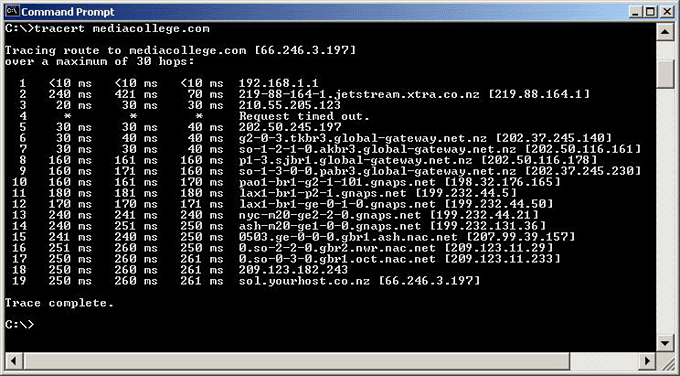How to Use the Traceroute Command
Traceroute is a command which can show you the path a packet of information takes from your computer to one you specify. It will list all the routers it passes through until it reaches its destination, or fails to and is discarded. In addition to this, it will tell you how long each 'hop' from router to router takes.
In Windows, select Start > Programs > Accessories > Command Prompt. This will give you a window like the one below.
Enter the word tracert, followed by a space, then the domain name.
The following is a successful traceroute from a home computer in New Zealand to mediacollege.com:

Firstly it tells you that it's tracing the route to
mediacollege.com, tells you the IP address of that domain, and
what the maximum number of hops will be before it times
out.
Next it gives information about each router it
passes through on the way to its destination.
1 is the
internet gateway on the network this traceroute was done from
(an ADSL modem in this case)
2 is the ISP the origin
computer is connected to (xtra.co.nz)
3 is also in the xtra
network
4 timed out
5 - 9 are all routers on the
global-gateway.net.nz network (the domain that is the internet
gateway out of New Zealand)
10 - 14 are all gnaps.net
in the USA (a telecom supplier in the USA)
15 - 17 are
on the nac network (Net Access Corporation, an ISP in the New
York area)
18 is a router on the network mediacollege.com is
hosted on
and finally, line 19 is the computer
mediacollege.com is hosted on (sol.yourhost.co.nz)
Each of the 3 columns are a response from that router, and
how long it took (each hop is tested 3 times). For example, in
line 2, the first try took 240ms (240 milliseconds), the second
took 421 ms, and the third took 70ms.
You will notice that
line 4 'timed out', that is, there was no response from the
router, so another one was tried (202.50.245.197) which was
successful.
You will also notice that the time it took
quadrupled while passing through the global-gateway network.
This is extremely useful when trying to find out why a
website is unreachable, as you will be able to see where the
connection fails. If you have a website hosted somewhere, it
would be a good idea to do a traceroute to it when it is
working, so that when it fails, you can do another traceroute
to it (which will probably time out if the website is
unreachable) and compare them. Be aware though, that it will
probably take a different route each time, but the networks it
passes through will generally be very similar.
If the
example above had continued to time out after line 9, you could
suspect that global-gateway.co.nz was the problem, and not
mediacollege.com.
If it timed out after line 1, you would
know there was a problem connecting to your ISP (in this case
you would not be able to access anything on the internet).
It is generally recommended that if you have a website that
is unreachable, you should use both the traceroute and ping
commands before you contact your ISP to complain. More often
that not, there will be nothing to your ISP or hosting company
can do about it.